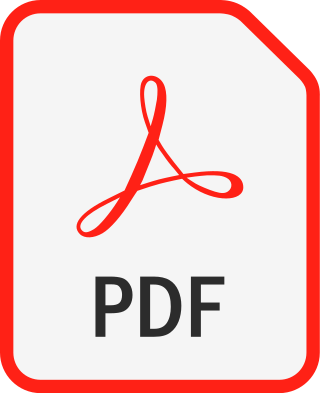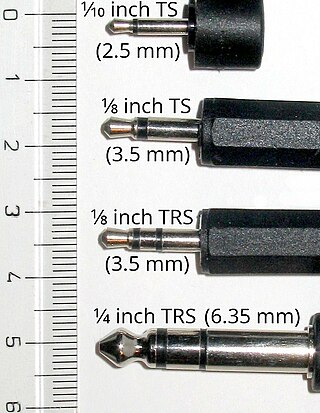
Portable Document Format (PDF), standardized as ISO 32000, is a file format developed by Adobe in 1992 to present documents, including text formatting and images, in a manner independent of application software, hardware, and operating systems. Based on the PostScript language, each PDF file encapsulates a complete description of a fixed-layout flat document, including the text, fonts, vector graphics, raster images and other information needed to display it. PDF has its roots in "The Camelot Project" initiated by Adobe co-founder John Warnock in 1991. PDF was standardized as ISO 32000 in 2008. The last edition as ISO 32000-2:2020 was published in December 2020.

PostScript is a page description language and dynamically typed, stack-based programming language. It is most commonly used in the electronic publishing and desktop publishing realm, but as a Turing complete programming language, it can be used for many other purposes as well. PostScript was created at Adobe Systems by John Warnock, Charles Geschke, Doug Brotz, Ed Taft and Bill Paxton from 1982 to 1984. The most recent version, PostScript 3, was released in 1997.

Universal Serial Bus (USB) is an industry standard that allows data exchange and delivery of power between many types of electronics. It specifies its architecture, in particular its physical interface, and communication protocols for data transfer and power delivery to and from hosts, such as personal computers, to and from peripheral devices, e.g. displays, keyboards, and mass storage devices, and to and from intermediate hubs, which multiply the number of a host's ports.

A 19-inch rack is a standardized frame or enclosure for mounting multiple electronic equipment modules. Each module has a front panel that is 19 inches (482.6 mm) wide. The 19 inch dimension includes the edges or ears that protrude from each side of the equipment, allowing the module to be fastened to the rack frame with screws or bolts. Common uses include computer servers, telecommunications equipment and networking hardware, audiovisual production gear, music production equipment, and scientific equipment.

In microelectronics, a dual in-line package is an electronic component package with a rectangular housing and two parallel rows of electrical connecting pins. The package may be through-hole mounted to a printed circuit board (PCB) or inserted in a socket. The dual-inline format was invented by Don Forbes, Rex Rice and Bryant Rogers at Fairchild R&D in 1964, when the restricted number of leads available on circular transistor-style packages became a limitation in the use of integrated circuits. Increasingly complex circuits required more signal and power supply leads ; eventually microprocessors and similar complex devices required more leads than could be put on a DIP package, leading to development of higher-density chip carriers. Furthermore, square and rectangular packages made it easier to route printed-circuit traces beneath the packages.

In computing, an expansion card is a printed circuit board that can be inserted into an electrical connector, or expansion slot on a computer's motherboard to add functionality to a computer system. Sometimes the design of the computer's case and motherboard involves placing most of these slots onto a separate, removable card. Typically such cards are referred to as a riser card in part because they project upward from the board and allow expansion cards to be placed above and parallel to the motherboard.

On computers, a serial port is a serial communication interface through which information transfers in or out sequentially one bit at a time. This is in contrast to a parallel port, which communicates multiple bits simultaneously in parallel. Throughout most of the history of personal computers, data has been transferred through serial ports to devices such as modems, terminals, various peripherals, and directly between computers.
A controller area network is a vehicle bus standard designed to allow microcontrollers and devices to communicate with each other. It is a message-based protocol, designed originally for multiplex electrical wiring within automobiles to save on copper, but it can also be used in many other contexts. For each device, the data in a frame is transmitted serially but in such a way that if more than one device transmits at the same time, the highest priority device can continue while the others back off. Frames are received by all devices, including by the transmitting device.

A phone connector is a family of cylindrically-shaped electrical connectors primarily for analog audio signals. Invented in the late 19th century for telephone switchboards, the phone connector remains in use for interfacing wired audio equipment, such as headphones, speakers, microphones, mixing consoles, and electronic musical instruments. A male connector, is mated into a female connector, though other terminology is used.

The DIN connector is an electrical connector that was standardized by the Deutsches Institut für Normung (DIN), the German Institute for Standards, in the mid 1950's, initially with 3 pins for mono, but when stereo connections and gear appeared in late 1950's, versions with 5 pins or more were launched. The male DIN connectors (plugs) feature a 13.2 mm diameter metal shield with a notch that limits the orientation in which plug and socket can mate. The range of DIN connectors, different only in the configuration of the pins, have been standardized as DIN 41524 / IEC/DIN EN 60130-9 ; DIN 45322 ; DIN 45329 / IEC/DIN EN 60130–9 ; and DIN 45326 / IEC/DIN EN 60130-9.

The D-subminiature or D-sub is a common type of electrical connector. They are named for their characteristic D-shaped metal shield. When they were introduced, D-subs were among the smallest connectors used on computer systems.

A banana connector is a single-wire electrical connector used for joining wires to equipment. The term 4 mm connector is also used, especially in Europe, although not all banana connectors will mate with 4 mm parts, and 2 mm banana connectors exist. Various styles of banana plug contacts exist, all based on the concept of spring metal applying outward force into the unsprung cylindrical jack to produce a snug fit with good electrical conductivity. Common types include: a solid pin split lengthwise and splayed slightly, a tip of four leaf springs, a cylinder with a single leaf spring on one side, a bundle of stiff wire, a central pin surrounded by a multiple-slit cylinder with a central bulge, or simple sheet spring metal rolled into a nearly complete cylinder. The plugs are frequently used to terminate patch cords for electronic test equipment such as laboratory power supply units, while sheathed banana plugs are common on multimeter probe leads.

In telecommunications, structured cabling is building or campus cabling infrastructure that consists of a number of standardized smaller elements called subsystems. Structured cabling components include twisted pair and optical cabling, patch panels and patch cables.
PDF/A is an ISO-standardized version of the Portable Document Format (PDF) specialized for use in the archiving and long-term preservation of electronic documents. PDF/A differs from PDF by prohibiting features unsuitable for long-term archiving, such as font linking and encryption. The ISO requirements for PDF/A file viewers include color management guidelines, support for embedded fonts, and a user interface for reading embedded annotations.
A proprietary file format is a file format of a company, organization, or individual that contains data that is ordered and stored according to a particular encoding-scheme, designed by the company or organization to be secret, such that the decoding and interpretation of this stored data is easily accomplished only with particular software or hardware that the company itself has developed. The specification of the data encoding format is not released, or underlies non-disclosure agreements. A proprietary format can also be a file format whose encoding is in fact published, but is restricted through licences such that only the company itself or licensees may use it. In contrast, an open format is a file format that is published and free to be used by everybody.
PDF/UA, formally ISO 14289, is an International Organization for Standardization (ISO) standard for accessible PDF technology. A technical specification intended for developers implementing PDF writing and processing software, PDF/UA provides definitive terms and requirements for accessibility in PDF documents and applications. For those equipped with appropriate software, conformance with PDF/UA ensures accessibility for people with disabilities who use assistive technology such as screen readers, screen magnifiers, joysticks and other technologies to navigate and read electronic content.
The following is a comparison of e-book formats used to create and publish e-books.
Audio connectors and video connectors are electrical or optical connectors for carrying audio or video signals. Audio interfaces or video interfaces define physical parameters and interpretation of signals. For digital audio and digital video, this can be thought of as defining the physical layer, data link layer, and most or all of the application layer. For analog audio and analog video these functions are all represented in a single signal specification like NTSC or the direct speaker-driving signal of analog audio.
The Portable Document Format (PDF) was created by Adobe Systems, introduced at the Windows and OS/2 Conference in January 1993 and remained a proprietary format until it was released as an open standard in 2008. Since then, it has been under the control of an International Organization for Standardization (ISO) committee of industry experts.










